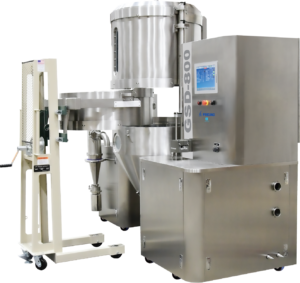
How three critical processes are shaping the future of energy storage.
In an era dominated by the quest for sustainable energy solutions, the significance of battery technology cannot be overstated. Batteries serve as the backbone of various industries, powering everything from portable electronics to electric vehicles and renewable energy systems. At the heart of these powerful energy storage devices lies a complex array of materials engineered to deliver optimal performance and reliability. Among the multitude of techniques employed in battery material processing, spray drying, fluid bed processing, and roll compaction stand out as pivotal methods in shaping the future of energy storage.
Battery material processing involves a series of intricate steps aimed at transforming raw materials into functional components of a battery cell. These components typically include electrodes (anodes and cathodes), electrolytes, separators, and current collectors. Each component plays a vital role in the electrochemical processes that occur within the battery, ultimately determining its performance characteristics, such as energy density, power output, and cycle life.
Spray Drying: Precision Engineering for Superior Performance
Spray drying has emerged as a cornerstone technique in the production of battery materials due to its unparalleled precision and efficiency. The process involves atomizing a liquid slurry containing active materials, binders, and additives into fine droplets, which are rapidly dried to form spherical particles. The resulting powder exhibits controlled particle size distribution and excellent morphology, making it ideal for electrode fabrication. FREUND’s systems are engineered to address limitations often encountered in other spray dryers and are equipped with modular components and accessories that allow for custom configurations to best suit the processes at hand.
Particle Size: Achieving precise control over the particle size distribution of battery materials involves selecting an appropriate spray nozzle and fine-tuning process parameters including inlet air temperature, atomization pressure, and slurry feed rate. Consistent particle size distribution is essential for optimizing electrode packing density, ensuring uniform electrolyte infiltration, and promoting efficient electrochemical reactions within the battery. Considering the wide array of requirements for particle size, various types of spray nozzles are available, each producing different particle sizes. FREUND, for example, specializes in producing particles as small as 3 µm and up to 60 µm, which is perfect for battery materials.
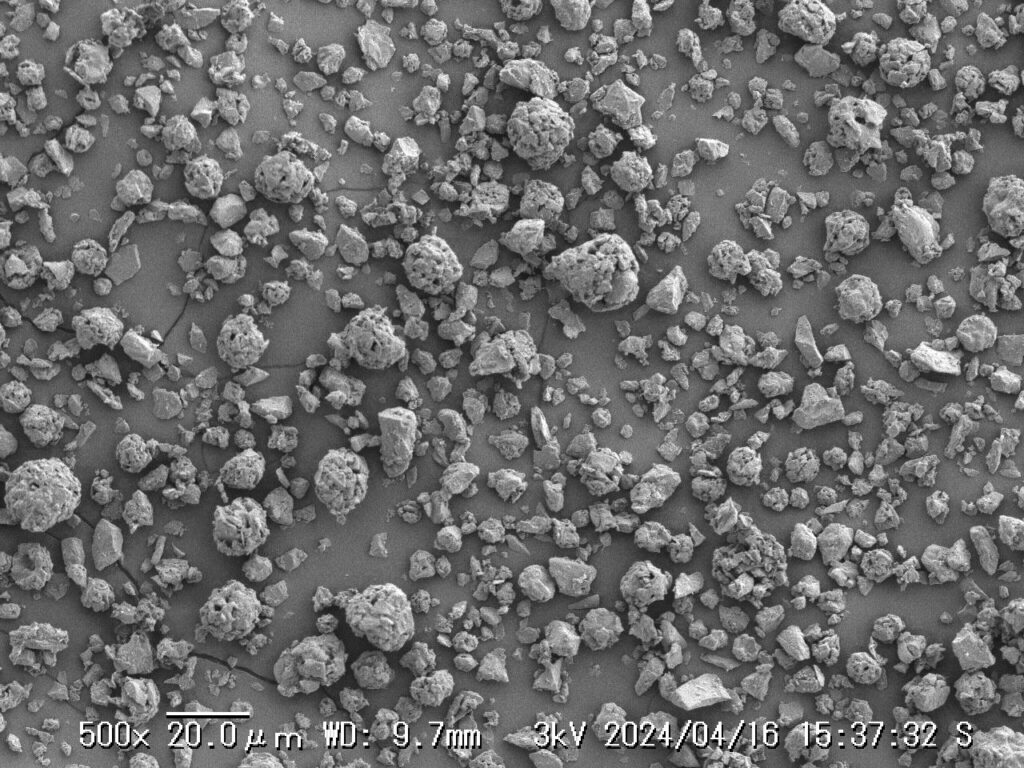
Homogeneous Mixing: The homogeneous mixing of active materials, binders, conductive additives, and solvents to form a well-dispersed slurry is critical for spray drying. This uniform distribution of components throughout the slurry ensures that each particle contains the necessary ingredients for optimal electrochemical performance. Homogeneous mixing promotes electrode stability, enhances electron and ion transport kinetics, and minimizes electrode degradation during charge-discharge cycles.
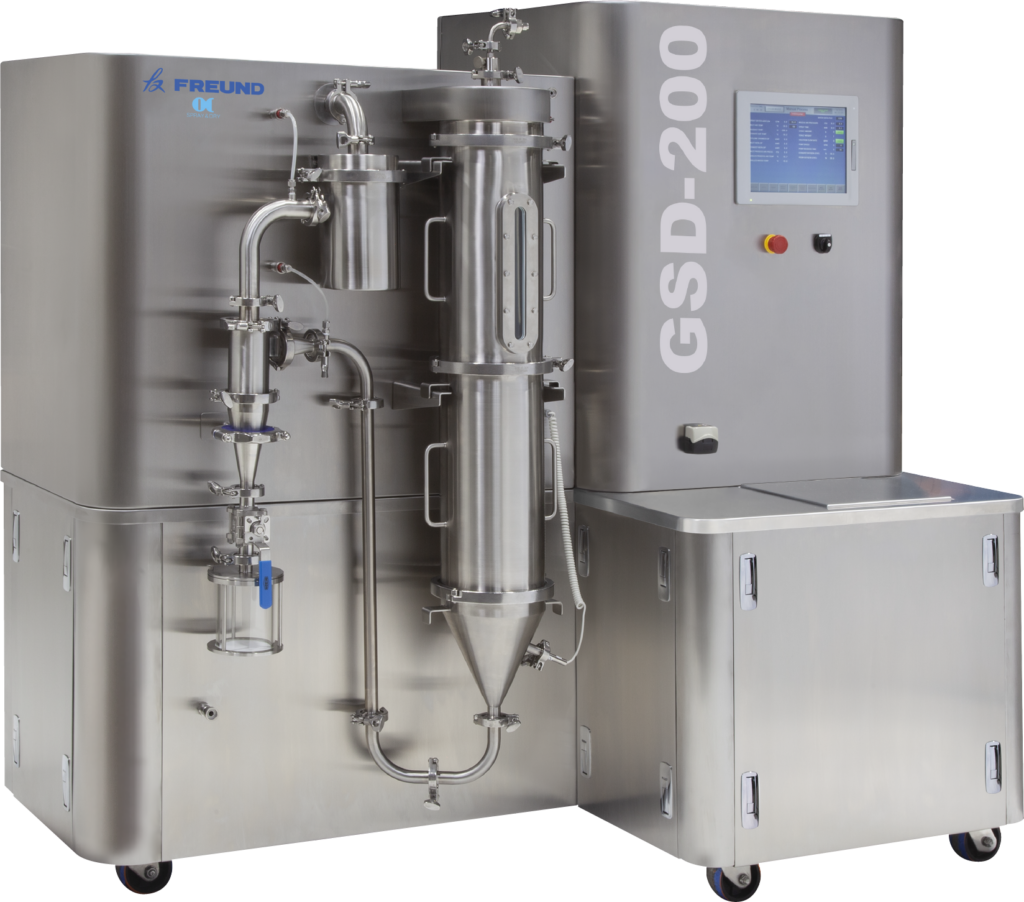
Surface Area Maximization: The atomization and rapid solvent evaporation during spray drying result in the formation of small, porous, high-surface-area particles. While two fluid-air atomizing nozzles are commonly used to generate these particles, there is an increasing demand for higher energy density, because small is not small enough. A groundbreaking new type of air atomizing spray gun called the Twin Jet spray nozzle was developed to generate even smaller particles. By utilizing dual collisions between the atomization air and the slurry, Twin Jet nozzles achieve extremely small particles. This increased surface area significantly enhances the accessibility of active materials to electrolyte ions, facilitating faster ion diffusion and improving the overall rate capability of the batteries. Furthermore, maximized surface area promotes efficient utilization of active materials, leading to higher energy and power densities in battery cells.
Polymer Distribution: Spray drying enables the uniform distribution of polymer materials within the electrode formulation. Polymers play a critical role in electrode integrity, providing mechanical support and adhesion between active materials and current collectors. Proper polymer distribution ensures strong electrode cohesion, prevents particle agglomeration, and enhances the structural stability of electrodes during electrochemical cycling.
Scalability and Cost-Effectiveness: Spray drying processes are highly scalable, allowing for seamless transition from laboratory-scale synthesis to mass production. FREUND, for example, offers machines with water evaporation capabilities ranging from 0.5 to 50 kg/h, ensuring versatility to meet diverse production needs. Moreover, the efficiency of spray drying minimizes material waste and processing time, resulting in cost-effective manufacturing solutions for battery materials.
Fluid Bed Processing: Coating, Drying, and Granulation
Fluid bed processing is a pivotal asset in battery material processing, offering versatile capabilities for coating, drying, and granulation of powdered materials. FREUND’s machines operate by fluidizing fine particles using a stream of heated gas, allowing for uniform deposition of coatings and efficient drying of wet materials.
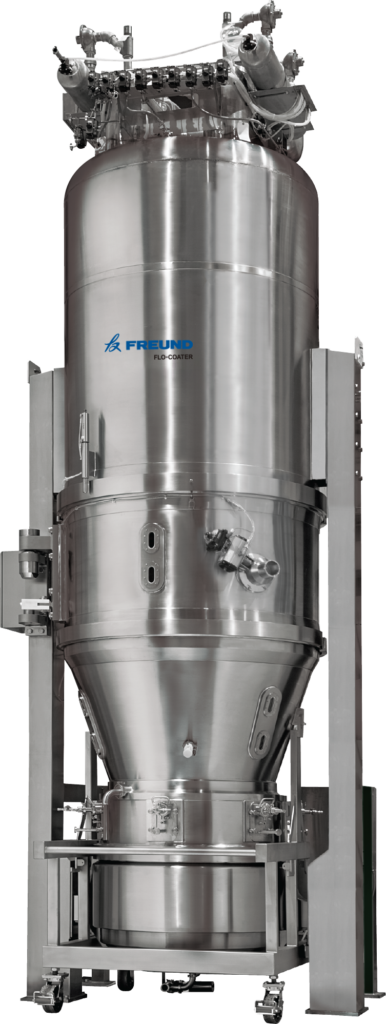
Coating and Encapsulation: Fluid bed Wurster processing enables precise coating and encapsulation of battery materials with protective layers. This is particularly important for enhancing the stability and lifespan of electrode materials, which are prone to degradation during electrochemical cycling. The Wurster process uses an air distribution plate, Wurster column, and bottom spray gun to provide controlled product movement and achieve highly uniform coating. FREUND’s bottom spray gun controls particle movement by using accelerator (diverter) air, a separate air stream from the atomization air that diverts the core particles away from the nozzle tip, resulting in enhanced coating uniformity and increased throughput. This accelerator air is adjustable during processing, enabling continuous optimization throughout the coating process. Combined with a uniquely designed air distribution plate, which allows for appropriate fluidization and coating of fine (10 μm) particles, FREUND’s bottom spray system is adept at coating the small particles commonly used in battery technologies.
Granulation: By maintaining a controlled fluidization environment, fluid bed top spray processing facilitates granulation of battery materials. This results in the formation of free-flowing granules with customizable properties, such as particle size distribution and bulk density, improving their handling characteristics and suitability for downstream processing.
Roll Compaction: Densification for Enhanced Performance
Roll compaction has emerged as a powerful technique for enhancing the density and mechanical properties of battery electrode materials. In this process, powdered materials are compressed between cantilevered rolls under high pressure, resulting in densification and the formation of dense sheets or ribbons.
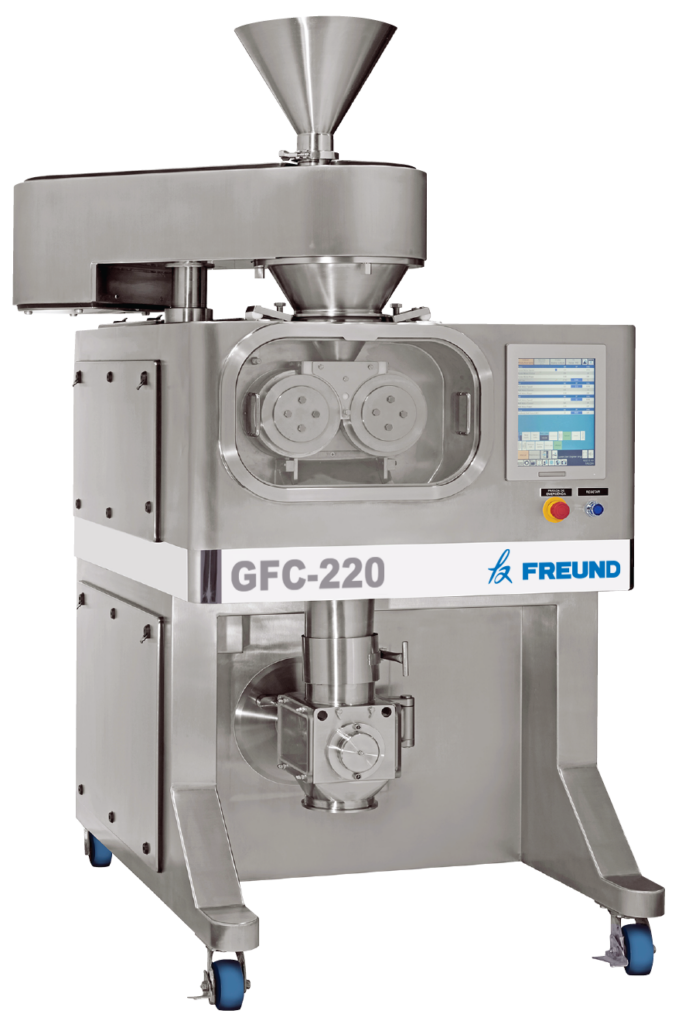
Density and Porosity Control: Roll compaction offers precise control over the density and porosity of battery electrode materials, which are critical factors influencing their electrochemical performance. By reducing porosity and increasing packing density, roll-compacted electrodes exhibit improved electrical conductivity and mechanical stability.
Uniformity and Consistency: The uniform compaction achieved through roll compaction ensures consistent electrode thickness and density, leading to enhanced electrochemical performance and cycling stability. This uniformity is essential for maintaining consistent cell-to-cell performance in battery packs and ensuring reliable operation in demanding applications.
Increased Energy Density: By compacting electrode materials to higher densities, roll compaction enables battery manufacturers to incorporate greater active material loadings, thereby increasing the energy density of battery cells. Using FREUND’s vertical tapered screw design and deaeration system, for example, roll compaction can greatly increase product density and allow for tighter packing factors, which can greatly improve energy density in the material. This enhancement in energy storage capacity is crucial for extending the range and runtime of battery-powered devices and vehicles.
Milling: Milling is the crucial final step of roll compaction, where the compacted sheets or ribbons of material are reduced to particles to the desired size. A range of mills are available that are adaptable for inline attachment below the roll compactor or as standalone units. Among the prevalent rotary mill variants are knife/hammer, conical, and rasping star mills, each capable of being integrated into the system’s interface. Conical mills are commonly used in battery operations as they are better for hard materials that are difficult to break apart. The application of milling facilitates precise control of particle size distribution to enhance flowability and ensure optimal product performance and uniformity.
Powder Handling – Ensuring Efficiency and Safety: In addition to spray drying, fluid beds, and roll compaction, battery manufacture requires a range of specialized material handling systems, covering every stage of the manufacturing process, from initial containment to final washing, ensuring the highest standards of safety, efficiency and quality. Containers are essential for storing and transporting powdered materials, electrolytes, and electrode components. Blending operations play a critical role in achieving homogeneity and consistency in electrode formulations. Lifts are then utilized to safely transport materials within a facility. Dense-phase and dilute-phase pneumatic vacuum conveying systems are used to transfer materials and can be tailored to the requirements of the product and process. Proper cleaning of equipment and containers is necessary to prevent contamination and maintain product quality. Bin washing stations and mobile/stationary wash skids offer a controlled environment for washing process equipment.
Future Outlook:
The importance of battery material processing by spray drying, fluid beds, and roll compaction extends across a wide range of applications, spanning the consumer electronics, automotive, aerospace, and grid energy storage sectors. In consumer electronics, these advanced processing techniques enable the fabrication of high-performance lithium-ion battery cells with enhanced energy density and longevity, powering smartphones, laptops, and wearable devices. In the automotive industry, they play a pivotal role in the development of next-generation electric vehicle batteries, offering improved energy efficiency, fast charging capabilities, and extended driving ranges. In grid energy storage applications, such as renewable energy integration and peak load management, advanced battery materials processed using these techniques contribute to the stability and reliability of the electrical grid, enabling greater penetration of renewable energy sources and reducing dependence on fossil fuels.
Looking ahead, continued advancements in battery material processing technologies are poised to drive further innovation and adoption of energy storage solutions worldwide. Emerging trends such as solid-state batteries, lithium-sulfur batteries, and sodium-ion batteries present new opportunities and challenges for material scientists and engineers, demanding novel processing techniques capable of meeting stringent performance and cost targets. Additionally, the integration of artificial intelligence, machine learning, and data analytics into battery material processing workflows holds the promise of accelerating materials discovery and optimization, paving the way for the development of next-generation energy storage technologies with unprecedented performance and sustainability.
If you would like to learn more about our solutions, please contact us today!
